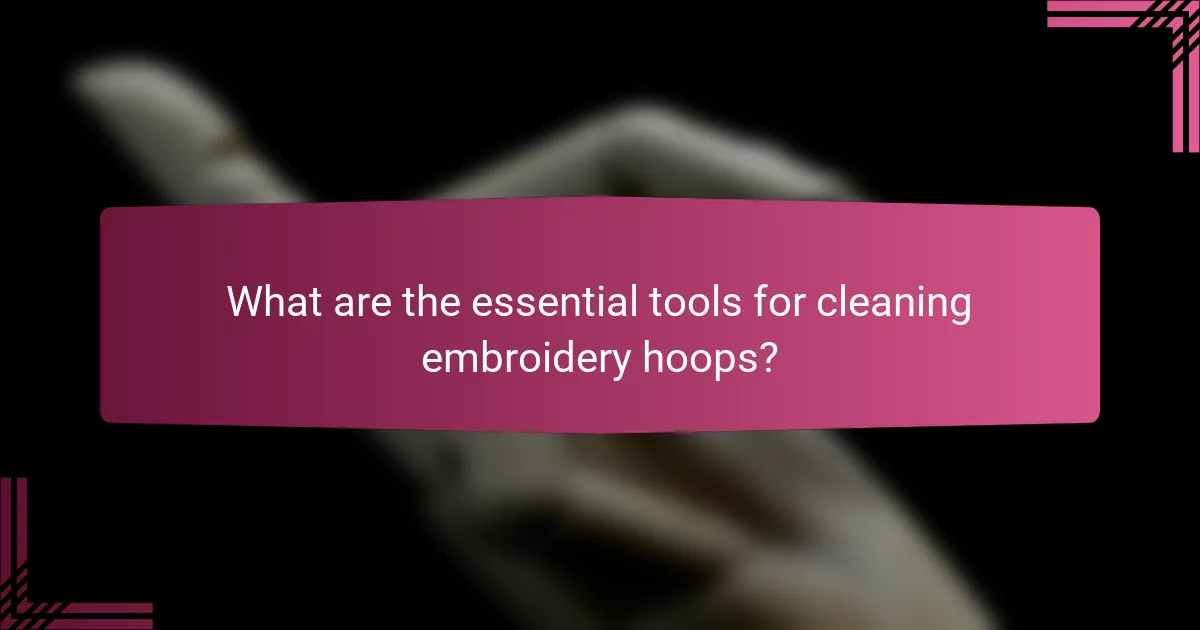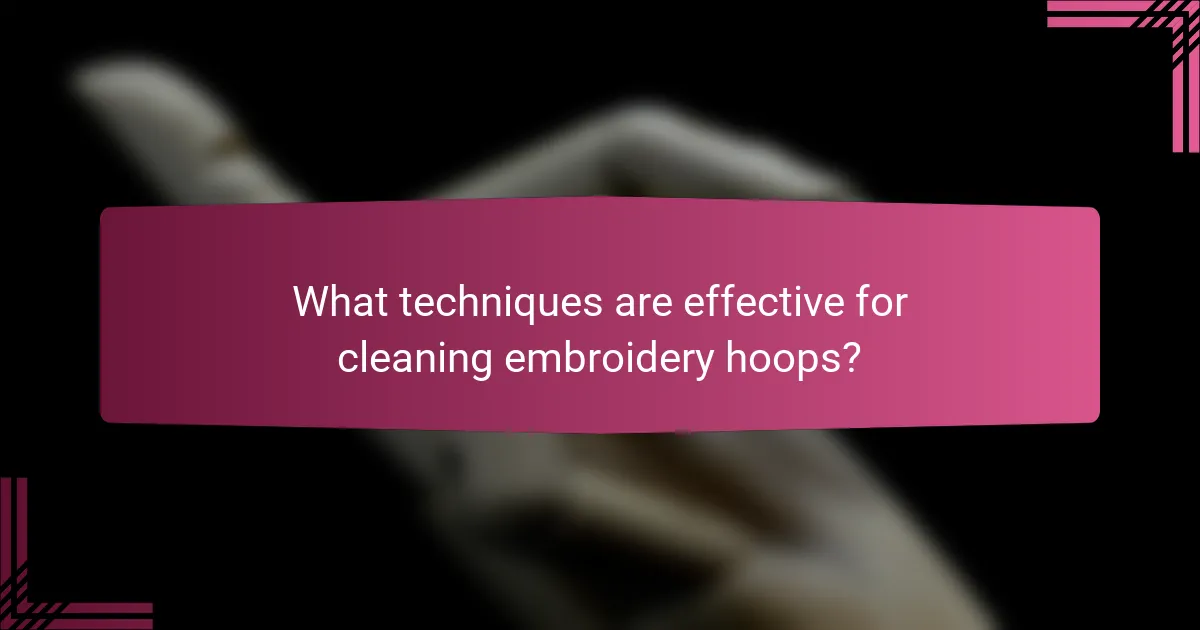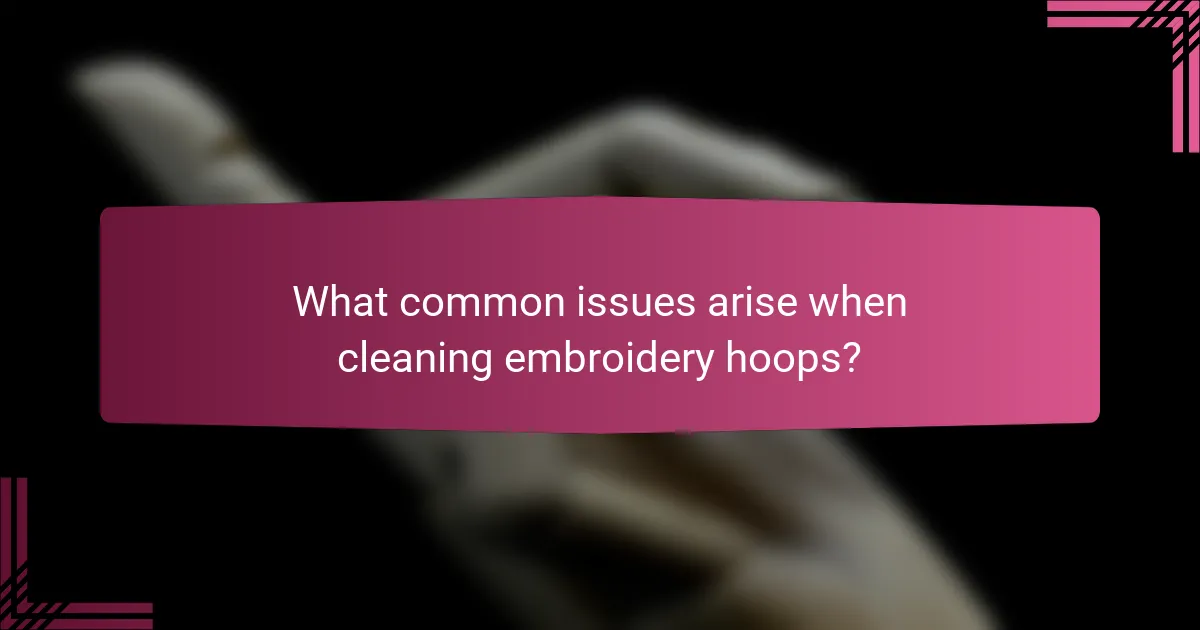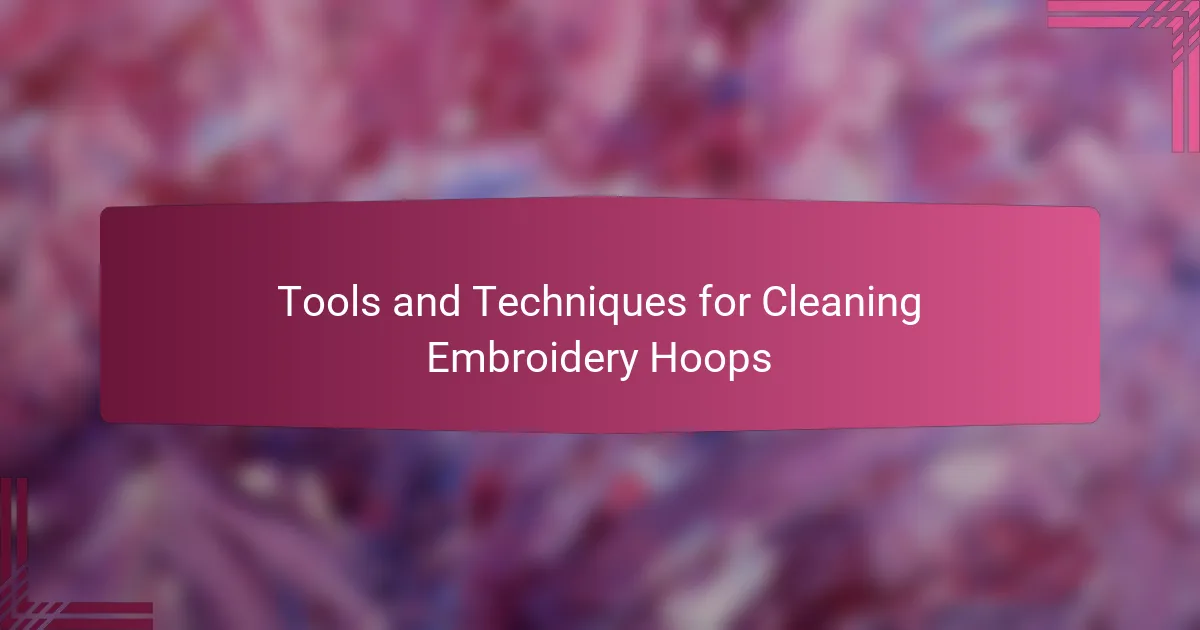
What are the essential tools for cleaning embroidery hoops?
The essential tools for cleaning embroidery hoops include a soft cloth, mild soap, and a toothbrush. A soft cloth helps to wipe away dust and debris without scratching the surface. Mild soap, mixed with water, effectively removes oils and stains. A toothbrush can reach into crevices for a thorough clean. Using these tools ensures that the embroidery hoops remain in good condition for future projects. Regular cleaning prevents buildup that can affect the embroidery process.
How do different tools contribute to the cleaning process?
Different tools enhance the cleaning process by targeting specific contaminants and improving efficiency. Brushes remove debris and lint from embroidery hoops, ensuring a clean surface. Cloths absorb moisture and oils, preventing buildup that can affect the quality of embroidery. Cleaning solutions break down grime and residue, facilitating easier removal. Vacuum attachments eliminate dust and particles from hard-to-reach areas. Each tool serves a unique purpose, contributing to a thorough cleaning routine. Proper tool selection can significantly reduce cleaning time and enhance the lifespan of embroidery hoops.
What are the most effective cleaning solutions for embroidery hoops?
The most effective cleaning solutions for embroidery hoops include mild soap and water, vinegar, and rubbing alcohol. Mild soap mixed with warm water effectively removes dirt and residue. Vinegar is a natural disinfectant that can also break down grime. Rubbing alcohol quickly evaporates and cleans surfaces without leaving residue. These solutions are safe for most materials used in embroidery hoops. Regular cleaning with these methods can prolong the life of the hoops.
How do brushes and cloths differ in their cleaning effectiveness?
Brushes are generally more effective than cloths for cleaning due to their ability to dislodge debris. Brushes have stiff bristles that penetrate surfaces, removing dirt and grime effectively. They are ideal for textured surfaces found on embroidery hoops. Cloths, however, are better suited for wiping and absorbing liquids. They can clean smooth surfaces but may not reach into crevices. Research shows that bristle-based tools can remove 50% more dirt compared to cloths on similar surfaces. Therefore, for thorough cleaning, brushes are often preferred over cloths.
What safety precautions should be taken when using cleaning tools?
When using cleaning tools, wear appropriate personal protective equipment (PPE) such as gloves and masks. Gloves protect hands from harsh chemicals and sharp edges. Masks prevent inhalation of harmful dust and fumes. Ensure proper ventilation in the cleaning area to avoid buildup of toxic substances. Inspect tools for damage before use to prevent accidents. Use tools according to manufacturer instructions to ensure safe operation. Store cleaning tools safely after use to prevent injuries. Follow these precautions to maintain a safe cleaning environment.
How can one avoid damaging embroidery hoops during cleaning?
To avoid damaging embroidery hoops during cleaning, use gentle cleaning methods. Avoid soaking the hoops in water, as this can warp the material. Instead, wipe them down with a damp cloth. For stubborn dirt, use a mild soap solution. Always dry the hoops immediately after cleaning to prevent moisture damage. Additionally, avoid abrasive cleaners or scrubbing pads that can scratch the surface. Handle the hoops carefully to prevent bending or breaking. These practices help maintain the integrity of the hoops over time.
What protective gear is recommended while cleaning?
Recommended protective gear while cleaning includes gloves, masks, and goggles. Gloves protect hands from chemicals and dirt. Masks prevent inhalation of dust and fumes. Goggles shield eyes from splashes and irritants. Using this gear minimizes health risks during cleaning tasks. It is essential for maintaining safety when handling cleaning agents.

What techniques are effective for cleaning embroidery hoops?
To clean embroidery hoops effectively, several techniques can be employed. First, use a damp cloth with mild soap to wipe the surfaces. This method removes dirt and oils without damaging the material. Second, for stubborn stains, a mixture of vinegar and water can be applied. Vinegar acts as a natural cleaner and deodorizer. Third, consider using rubbing alcohol on a cotton ball for disinfecting purposes. This technique is effective in killing germs and bacteria. Lastly, avoid soaking the hoops in water. Prolonged exposure can warp the wood or plastic. These methods ensure the longevity of the embroidery hoops while keeping them clean.
How do you properly clean wooden embroidery hoops?
To properly clean wooden embroidery hoops, first, remove any fabric or thread from the hoop. Next, use a soft cloth slightly dampened with water to wipe down the wood. Avoid soaking the wood, as excess moisture can cause warping. For stubborn stains, a mild soap solution can be applied with a cloth, followed by a thorough wipe with a clean, dry cloth. Ensure the hoops are completely dry before storing them. Regular cleaning helps maintain the wood’s integrity and appearance.
What specific methods work best for removing stains from wood?
The best methods for removing stains from wood include using a mixture of vinegar and olive oil, baking soda paste, and commercial wood cleaners. Vinegar and olive oil effectively lift stains while conditioning the wood. Baking soda paste, made by mixing baking soda with water, can scrub away tougher stains without damaging the surface. Commercial wood cleaners often contain specific ingredients designed to penetrate and remove stains. Testing any method on a small, inconspicuous area first is crucial to prevent damage. Regular maintenance can help prevent future staining.
How can you maintain the integrity of the wood while cleaning?
To maintain the integrity of the wood while cleaning, use a gentle approach. Avoid harsh chemicals that can damage the wood’s surface. Instead, opt for a mild soap mixed with water. Dampen a soft cloth with the soapy solution. Wipe the wood gently, ensuring not to saturate it. Dry the wood immediately with a clean, dry cloth. This method preserves the wood’s finish and prevents warping. Regular maintenance with this technique extends the lifespan of the wood.
What are the best practices for cleaning plastic embroidery hoops?
The best practices for cleaning plastic embroidery hoops include using mild soap and warm water. First, disassemble the hoop if possible. This allows for easier cleaning of all parts. Next, mix a solution of mild soap and warm water. Soak a soft cloth or sponge in the solution. Wipe down the plastic surfaces thoroughly. Avoid abrasive materials that can scratch the plastic. Rinse the hoop with clean water to remove any soap residue. Finally, dry the hoop completely before reassembling. These steps help maintain the integrity and longevity of the embroidery hoops.
What solutions are safe for use on plastic materials?
Water-based cleaners are safe for use on plastic materials. These cleaners do not contain harsh chemicals that can damage the plastic. Mild dish soap mixed with water is an effective solution. Vinegar diluted in water is also safe and helps remove stains. Isopropyl alcohol can be used for disinfecting without harming the plastic. It’s important to avoid abrasive cleaners that can scratch surfaces. Always test a small area first to ensure compatibility. Using these solutions helps maintain the integrity of plastic materials.
How can you prevent scratches and damage while cleaning plastic hoops?
To prevent scratches and damage while cleaning plastic hoops, use a soft cloth for wiping. Avoid abrasive materials that can create scratches. Opt for mild soap mixed with water for cleaning solutions. Rinse thoroughly to remove any soap residue. Dry the hoops with a soft towel instead of air drying. Store the hoops in a protective case to avoid contact with hard surfaces. Regular maintenance reduces the risk of long-term damage. Following these steps ensures the longevity of plastic hoops.

What common issues arise when cleaning embroidery hoops?
Common issues when cleaning embroidery hoops include rust formation and damage to the finish. Rust can develop if metal hoops are exposed to moisture during cleaning. Damage to the finish may occur if abrasive cleaners are used. Additionally, residue from cleaning agents can remain on the hoop, affecting future projects. Improper drying techniques can lead to warping of wooden hoops. Lastly, using too much water can loosen the fabric tension. These issues can hinder the longevity and usability of embroidery hoops.
What are the typical challenges faced during the cleaning process?
Typical challenges faced during the cleaning process include residue buildup, delicate materials, and hard-to-reach areas. Residue buildup can occur from adhesives, threads, and fabrics used in embroidery. Delicate materials may require special cleaning solutions to avoid damage. Hard-to-reach areas complicate thorough cleaning, as dirt can accumulate in these spots. Additionally, time constraints may limit the effectiveness of the cleaning process. Proper tools and techniques are essential to overcome these challenges. Using appropriate cleaning agents can prevent damage while ensuring effectiveness.
How can residue from cleaning solutions affect embroidery hoops?
Residue from cleaning solutions can damage embroidery hoops. This residue may cause discoloration or staining on the hoop’s surface. It can also lead to a sticky film that attracts dirt and lint. Over time, this can interfere with the fabric’s tension during stitching. Additionally, some cleaning agents can weaken the material of the hoop. For example, solvents may degrade plastic or wood, leading to cracks or breakage. Regular cleaning without proper rinsing can thus compromise the integrity and longevity of embroidery hoops.
What steps can be taken to troubleshoot stubborn stains?
Identify the type of stain present on the fabric. Different stains require specific treatments. Pre-treat the stain with a suitable stain remover. Apply the product directly to the stain and let it sit for a few minutes. Blot the area gently with a clean cloth to lift the stain. Rinse the fabric with cold water to remove the stain remover. Wash the fabric according to its care instructions. Repeat the process if the stain persists.
What tips can enhance the cleaning experience for embroidery hoops?
To enhance the cleaning experience for embroidery hoops, use gentle soap and warm water. This combination effectively removes dirt without damaging the hoop. A soft cloth or sponge is ideal for scrubbing. Avoid abrasive materials that can scratch the surface. Rinse thoroughly to eliminate any soap residue. Dry the hoops immediately to prevent rust or corrosion. Regular cleaning after each use maintains their condition. Following these steps ensures longevity and optimal performance of the embroidery hoops.
How often should embroidery hoops be cleaned for optimal maintenance?
Embroidery hoops should be cleaned after every use for optimal maintenance. Regular cleaning prevents the buildup of dirt and oils. This practice ensures that the fabric remains clean and free from stains. Additionally, it helps maintain the integrity of the hoop. Frequent cleaning also extends the lifespan of the embroidery tools. Using a damp cloth or mild soap is recommended for cleaning. This method effectively removes any residue without damaging the hoop. Consistency in cleaning is key to maintaining the quality of embroidery work.
What are the signs that embroidery hoops need cleaning?
Embroidery hoops need cleaning when they show visible dirt or grime. Accumulated dust or fabric lint can be seen on the surface. Additionally, if the hoop feels sticky or tacky, it indicates residue buildup. Another sign is discoloration or staining on the wood or plastic. If the fabric is not sliding smoothly, it may be due to dirt on the hoop. Regular inspection for these signs helps maintain the quality of the embroidery tools.
The main entity of this article is “embroidery hoops,” focusing on the essential tools and techniques for their cleaning. The article details the necessary cleaning tools, such as soft cloths, mild soap, and brushes, and explains their specific contributions to the cleaning process. It also covers effective cleaning solutions, safety precautions, and best practices for maintaining both wooden and plastic embroidery hoops. Common challenges faced during cleaning and tips for enhancing the cleaning experience are discussed, along with signs that indicate the need for cleaning. Regular maintenance is emphasized to ensure the longevity and optimal performance of embroidery tools.
